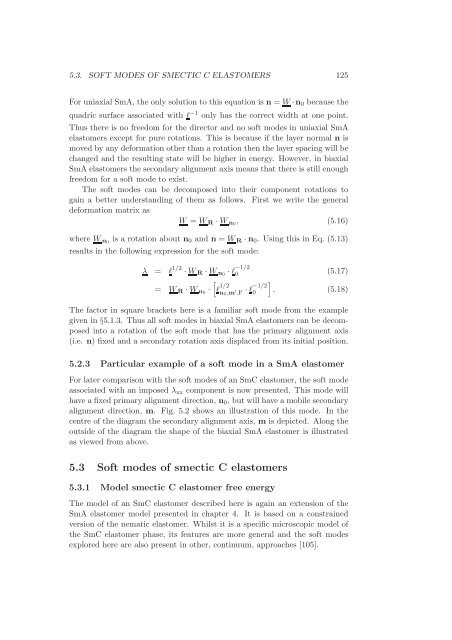Statistical models of elasticity in main chain and smectic liquid ...
Statistical models of elasticity in main chain and smectic liquid ...
Statistical models of elasticity in main chain and smectic liquid ...
You also want an ePaper? Increase the reach of your titles
YUMPU automatically turns print PDFs into web optimized ePapers that Google loves.
5.3. SOFT MODES OF SMECTIC C ELASTOMERS 125For uniaxial SmA, the only solution to this equation is n = W·n 0 because thequadric surface associated with l −1 only has the correct width at one po<strong>in</strong>t.Thus there is no freedom for the director <strong>and</strong> no s<strong>of</strong>t modes <strong>in</strong> uniaxial SmAelastomers except for pure rotations. This is because if the layer normal n ismoved by any deformation other than a rotation then the layer spac<strong>in</strong>g will bechanged <strong>and</strong> the result<strong>in</strong>g state will be higher <strong>in</strong> energy. However, <strong>in</strong> biaxialSmA elastomers the secondary alignment axis means that there is still enoughfreedom for a s<strong>of</strong>t mode to exist.The s<strong>of</strong>t modes can be decomposed <strong>in</strong>to their component rotations toga<strong>in</strong> a better underst<strong>and</strong><strong>in</strong>g <strong>of</strong> them as follows. First we write the generaldeformation matrix asW = W R ·W n0 , (5.16)where W n0 is a rotation about n 0 <strong>and</strong> n = W R ·n 0 . Us<strong>in</strong>g this <strong>in</strong> Eq. (5.13)results <strong>in</strong> the follow<strong>in</strong>g expression for the s<strong>of</strong>t mode:λ = l 1/2 ·W R ·W n0 ·l −1/20[ ](5.17)= W R ·W n0 · l 1/2n 0 ,m ′ ,l·l −1/2′ 0 . (5.18)The factor <strong>in</strong> square brackets here is a familiar s<strong>of</strong>t mode from the examplegiven <strong>in</strong> §5.1.3. Thus all s<strong>of</strong>t modes <strong>in</strong> biaxial SmA elastomers can be decomposed<strong>in</strong>to a rotation <strong>of</strong> the s<strong>of</strong>t mode that has the primary alignment axis(i.e. n) fixed <strong>and</strong> a secondary rotation axis displaced from its <strong>in</strong>itial position.5.2.3 Particular example <strong>of</strong> a s<strong>of</strong>t mode <strong>in</strong> a SmA elastomerFor later comparison with the s<strong>of</strong>t modes <strong>of</strong> an SmC elastomer, the s<strong>of</strong>t modeassociated with an imposed λ xx component is now presented. This mode willhave a fixed primary alignment direction, n 0 , but will have a mobile secondaryalignment direction, m. Fig. 5.2 shows an illustration <strong>of</strong> this mode. In thecentre <strong>of</strong> the diagram the secondary alignment axis, m is depicted. Along theoutside <strong>of</strong> the diagram the shape <strong>of</strong> the biaxial SmA elastomer is illustratedas viewed from above.5.3 S<strong>of</strong>t modes <strong>of</strong> <strong>smectic</strong> C elastomers5.3.1 Model <strong>smectic</strong> C elastomer free energyThe model <strong>of</strong> an SmC elastomer described here is aga<strong>in</strong> an extension <strong>of</strong> theSmA elastomer model presented <strong>in</strong> chapter 4. It is based on a constra<strong>in</strong>edversion <strong>of</strong> the nematic elastomer. Whilst it is a specific microscopic model <strong>of</strong>the SmC elastomer phase, its features are more general <strong>and</strong> the s<strong>of</strong>t modesexplored here are also present <strong>in</strong> other, cont<strong>in</strong>uum, approaches [105].
















